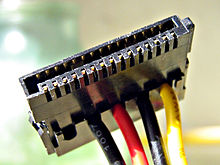Computer Support/Hardware/Power Supplies
Appearance
This lesson covers power supplies.
Objectives and Skills
[edit | edit source]Objectives and skills for the power supplies portion of A+ certification include:[1]
- Install a power supply based on given specifications.
- Connector types and their voltages
- SATA
- Molex
- 4/8-pin 12v
- PCIe 6/8-pin
- 20-pin
- 24-pin
- Specifications
- Wattage
- Dual rail
- Size
- Number of connectors
- ATX
- Micro-ATX
- Dual voltage options
- Connector types and their voltages
Readings
[edit | edit source]- Wikipedia: Power supply unit (computer)
- Wikipedia: Electric power
- overclock.net: Single Rail vs. Multi Rail *Explained*
- Wikipedia: ATX#Power Supply
Multimedia
[edit | edit source]- YouTube: PC Power Connectors - CompTIA A+ 220-901: 1.8
- YouTube: Computer Power Specifications - CompTIA A+ 220-901: 1.8
Activities
[edit | edit source]Lesson Summary
[edit | edit source]
- SATA specifies a different power connector than the four-pin Molex connector used on Parallel ATA (PATA) devices (and earlier small storage devices, going back to ST-506 hard drives and even to floppy drives that predated the IBM PC). It is a wafer-type connector, like the SATA data connector, but much wider (fifteen pins versus seven) to avoid confusion between the two. Some early SATA drives included the four-pin Molex power connector together with the new fifteen-pin connector, but most SATA drives now have only the latter.[2]


- The Molex Mini-fit Jr. (5566-20A or 5566-24A) motherboard power connectors may be used on ATX motherboards as the main power connector. 4, 6 and 8 pin configurations of the same style of connector are used for additional CPU power and graphics card power. This is changing as power, signal and speed requirements increase in sophistication and electronic requirements. These connectors are polarized so that they usually cannot be inserted incorrectly, and lock into position using a latch.[3]
- ATX12V 4-pin power connector (also called the P4 power connector). A second connector that goes to the motherboard (in addition to the main 24-pin connector) to supply dedicated power for the processor. For high-end motherboards and processors, more power is required, therefore EPS12V has an 8-pin connector.[4]
- Most modern computer power supplies include six-pin connectors that are generally used for PCI Express graphics cards, but a newly introduced eight-pin connector should be seen on the latest model power supplies. Each PCI Express 6-pin connector can output a maximum of 75 W. For the purpose of backwards compatibility, some connectors designed for use with high end PCI Express graphics cards feature a 6+2 pin configuration. It allows either a six-pin card or an eight-pin card to be connected by using two separate connection modules wired into the same sheath: one with six pins and another with two pins. Each PCI Express eight-pin connector can output a maximum of 150 W.
- PC Main power connector (usually called P1): This is the connector that goes to the motherboard to provide it with power. The connector has 20 or 24 pins. One of the pins belongs to the PS-ON wire (it is usually green). This connector is the largest of all the connectors. In older AT power supplies, this connector was split in two: P8 and P9. A power supply with a 24-pin connector can be used on a motherboard with a 20-pin connector. In cases where the motherboard has a 24-pin connector, some power supplies come with two connectors (one with 20-pin and other with 4-pin) which can be used together to form the 24-pin connector.[5]
- Electric power is the rate at which electrical energy is transferred by an electric circuit. The SI unit of power is the watt, one joule per second. The term wattage is used colloquially to mean "electric power in watts." Electric power is transformed to other forms of energy when electric charges move through an electric potential (voltage) difference, which occurs in electrical components in electric circuits.[6]
- A power supply rail or voltage rail refers to a single voltage provided by a power supply unit (PSU). A dual rail connection has multiple traces on the motherboard for power distribution, which are each monitored separately to protect from overcurrent.[7]
- The ATX specification requires the power supply to produce three main outputs, +3.3 V, +5 V and +12 V. Low-power −12 V and 5 VSB (standby) supplies are also required. Originally, the motherboard was powered by one 20-pin connector. An ATX power supply provides a number of peripheral power connectors and (in modern systems) two connectors for the motherboard: a 4-pin auxiliary connector providing additional power to the CPU and a main 24-pin power supply connector, an extension of the original 20-pin version. 20-pin MOLEX 39-29-9202 at the motherboard. 20-pin MOLEX 39-01-2200 at the cable.[8]
References
[edit | edit source]- ↑ CompTIA: A+ Certification Exam Objectives - Exam 220-901
- ↑ Wikipedia: Serial ATA#Power connectors
- ↑ Wikipedia: Molex connector
- ↑ Wikipedia: Power supply unit (computer)#Connectors
- ↑ Wikipedia: Power supply unit (computer)#Connectors
- ↑ Wikipedia: Electric power
- ↑ Wikipedia: Power supply unit (computer)
- ↑ Wikipedia: ATX#Power Supply

